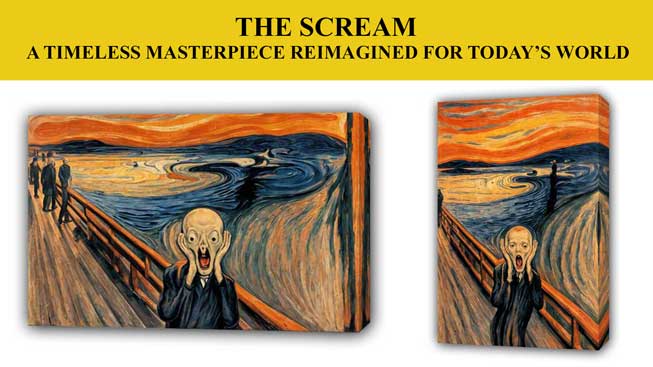
Edvard Munch’s The Scream: A Timeless Masterpiece Reimagined for Today’s World
Edvard Munch’s The Scream is one of the most recognizable and haunting paintings in art history. Painted in 1893, this masterpiece captures raw human emotion, anxiety, and existential dread—feelings that remain profoundly relevant in today’s fast-paced, digital, and ever-evolving world. While the original The Scream belongs to the Expressionist movement, modern artists and designers have reinterpreted it in contemporary styles, making it more accessible and relatable to a new generation.
The Timeless Emotion of The Scream
Munch’s painting depicts a figure standing on a bridge, hands gripping their face in horror, as swirling colors of orange and red in the background create an atmosphere of chaos and tension. The emotions it conveys—fear, anxiety, and isolation—resonate deeply in our modern era, where issues like climate change, mental health crises, and digital overload weigh heavily on our minds.
Modern Reinterpretations: A Contemporary Lens
With the rise of digital art, street art, and mixed-media, The Scream has been reimagined in numerous ways that speak to our present-day anxieties and culture. Some of the most intriguing modern adaptations include:
1. Digital and AI-Generated Versions
AI-powered art tools and digital artists have created new renditions of The Scream, adapting its colors, textures, and even merging it with futuristic elements. These digital versions often depict themes of technological anxiety, where the screaming figure is overwhelmed by social media, artificial intelligence, or virtual reality.
2. Pop Art and Street Art Interpretations
Contemporary artists have taken The Scream into the streets, using graffiti and pop-art styles to make it more relatable to urban environments. From neon-infused renditions to bold, comic-style outlines, these interpretations bring a fresh and edgy feel to the iconic image.
3. Satirical and Meme Culture Adaptations
In today’s internet-driven world, The Scream has found a new home in meme culture. It has been humorously repurposed to depict everyday struggles—be it WiFi issues, the pressures of work, or the never-ending notifications of social media. While lighthearted, these adaptations still echo the deep-seated anxieties of modern life.
4. Abstract and Minimalist Approaches
Modern contemporary artists have also embraced minimalism when reinterpreting The Scream. Stripped-down versions, using only a few brushstrokes or abstract geometric forms, highlight the essence of the original emotion while appealing to the sleek aesthetics of today’s art lovers.
Why The Scream Still Resonates Today
The enduring appeal of The Scream lies in its universal expression of fear and anxiety. Whether through digital adaptations, pop culture references, or high-end contemporary art, its core message remains unshaken: a deep reflection of the human condition. In today’s world, where stress and uncertainty are at an all-time high, The Scream continues to be a mirror of our collective psyche.
Enjoying The Scream in Modern Art Spaces
For those who appreciate contemporary takes on classic art, many artists and designers have created home décor, digital wallpapers, and NFT versions of The Scream that fit seamlessly into modern interiors. Whether you want a neon-infused print or a sleek, abstract version, these contemporary adaptations allow art lovers to experience Munch’s genius in a way that aligns with today’s aesthetics.
Conclusion
Edvard Munch’s The Scream is more than just a historical artwork; it is an emotion, a statement, and a piece of cultural identity that has stood the test of time. With modern reinterpretations breathing new life into this masterpiece, it continues to engage and inspire, proving that great art evolves while remaining eternally relevant.

Comments : (0)